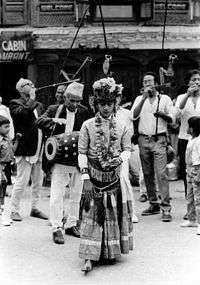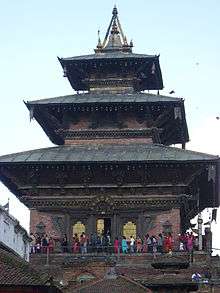Kumha Pyakhan dance
Kumha Pyakhan (Devanagari: कुम्ह प्याखं) is a sacred dance of the Tuladhar and Kansakar caste groups of the Newars of Kathmandu. The dance (alternative name: Kumar Pyakhan) is performed in temple and market squares during religious festivals.[1][2]


The dancer
A young boy impersonating the god Kumha performs the dance accompanied by a musical band consisting of drum and trumpet players. The dancer, who carries a bow and arrow, symbolically protects the image of the goddess Taleju when it is brought out of her temple at Kathmandu Durbar Square. Performances are held on the seventh and tenth days of the Mohani festival (Dasain) which takes place in October.[1] The dance is also performed on the stone platform at Asan, Kathmandu.
Selection
The dancer is chosen by lot from among the Tuladhars of Asan and Kansakars of Jana Baha. He receives training from a Gubhaju or Bajracharya priest. The dancer's term lasts around five years when he has to adhere to the rules of his office, which include daily worship of Nasadyah, the god of dance, and eating restrictions.[3]
The Kumha Pyakhan has not been performed since 1998 for lack of funding and candidates when Dibesh Kaji Tuladhar played the part of the deity.[4][5]
References
- Hoek, Bert van den; Shrestha, Balgopal (July 1992). "Guardians of the Royal Goddess: Daitya and Kumar as the Protectors of Taleju Bhavani of Kathmandu" (PDF). CNAS Journal. Retrieved 15 May 2012. Page 192.
- Lewis, Todd T. (January 1996). "Notes on the Uray and the Modernization of Newar Buddhism" (PDF). Contributions to Nepalese Studies. Retrieved 15 May 2012. Page 112.
- Hoek, Bert van den; Shrestha, Balgopal (July 1992). "Guardians of the Royal Goddess: Daitya and Kumar as the Protectors of Taleju Bhavani of Kathmandu" (PDF). CNAS Journal. Retrieved 15 May 2012. Pages 192-197.
- Tuladhar, Kamal Ratna (29 June 2012). "The last dance". The Kathmandu Post. Retrieved 16 September 2012.
- Bhintuna Guthi Lumanti Pau (2003). Kathmandu: Bhintuna Guthi. Page 43.